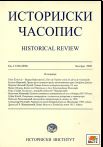Развојни циклус породичног домаћинства средином 19. века. Пример села Гостиља
Family Household Developmental Cycle in the Mid-1800s. A Case Study of the Village Gostilje
Author(s): Aleksandra VuletićSubject(s): History
Published by: Istorijski institut, Beograd
Keywords: family; household; zadruga; house; tax
Summary/Abstract: The paper analyses the developmental cycle of a family household in a chronological perspective, on the example of the Zlatibor village of Gostilje. The analysis draws on population censuses of 1849, 1857 and 1863. We identified the majority of families registered in 1849 in the following two censuses and compared their structures. Of 60 family households that we analysed in the time span of 1849–1857–1863, only 16 had the same structure in all three years. The majority of them – 13, were nuclear, one was the stem family, while two were complex (in the meantime, one nuclear household emerged from each of the two complex households). Within the same timespan, the majority of complex families divided into several families or lost their complex character with the death of some of their members. On the other hand, of 16 complex families from the last analysed census of 1863, the majority of them – nine, sprang from families that had been nuclear in 1849. In the observed 14-year period, a vast majority of family households in Gostilje were changing their structure – they split and became more complex, only to split again. The frequency of these changes was under a strong impact of demographic circumstances – early marriages and high fertility rates and (somewhat lower) mortality rates; an accelerated life cycle of an individual sped up the developmental cycle of a family household. Material factors were also behind the decisions to split households. As we have seen, in the mid-19th century, there was still sufficient free land, and the quantity of capital needed to establish a new household was minimum. As a family household did not represent only a biological community, but also an economic whole, the question remains as to what extent the structure of a household was determined by its economic logic – the self-sufficient method of earning limited to ensuring economic minimum. Frequent changes in the structure and their cyclical character support Bogišić’s thesis that there were no essential differences between nuclear and complex households, but that both types of households performed their economic functions in the same way.
Journal: Историјски часопис
- Issue Year: 2015
- Issue No: 64
- Page Range: 287-312
- Page Count: 26
- Language: Serbian

